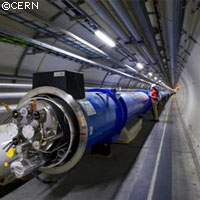Large Hadron Collider delay
The Large Hadron Collider (LHC) - the world's most powerful particle accelerator - will not become operational in November as originally planned. The delay in completing the installation of the 27 km circumference tunnel, in which scientists will attempt to reproduce the first instances of the Big Bang, has yet to be officially confirmed by the European Organisation for Nuclear Research (CERN) - the body responsible for building the collider. But James Gillies, a spokesperson at CERN, told CORDIS News that a new calendar is expected to be published on 22 June when the CERN Council meet. Reports indicate that the principal cause for the setback is due to the failure of a Fermilab-built 'inner triplet' of superconducting magnets during a routine pressure test in March. Each triplet contains three superconducting magnet assemblies, a cryogenic and power distribution box for the magnets, and associated structures. The triplets focus particle beams prior to particle collisions in the LHC. The CERN review team examined the mechanical design of the inner triplet to make sure that there are no further hidden defects, and conducted a review of the proposed in-situ repairs. The operational planning has also been hampered by the unforeseen time it took to cool down the first sector of the LHC ring. The entire 27-kilometre ring needs to be cooled down to a temperature of -271°C (colder than deep outer space) in order for the superconducting magnets that guide and focus the proton beams to remain in a superconductive state. Such a state allows the current to flow without resistance, creating a dense, powerful magnetic field in relatively small magnets. A total of 1,650 main magnets need to be operated in a superconductive state, which presents a huge technical challenge Due to an accumulation of delays, there was not enough time to squeeze in an engineer run as planned in November, before the site closed for the winter, Mr Gillies told CORDIS News. The run would have entailed putting a beam in each direction in the collider, but without particle acceleration. This would have allowed engineers and scientist to get 'a feel of what the data from the collider looks like,' said Mr Gillies. Nevertheless, the setback will not affect the start-up of research activities, which is foreseen for spring 2008, said Mr Gillies. The facility is expected to provide physicists with an unrivalled high-tech tool to study fundamental physics. It is also expected to enable the EU to maintain its leading role in fundamental research in the field of particle physics.



